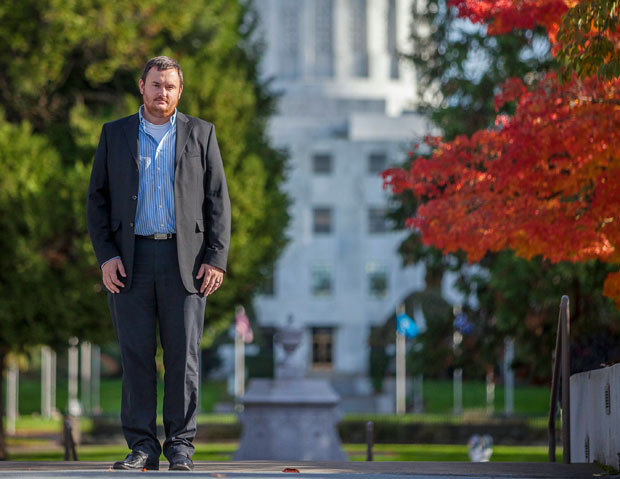BY LINDA BAKER
A conversation with Oregon state economist Josh Lehner.
A conversation with Oregon state economist Josh Lehner.

BY LINDA BAKER | PHOTO BY JASON E. KAPLAN
OB: The Powerbook features 15 industry sectors in the professional services category. How is that broad swath of businesses faring?
JL: Where growth is strong in this region, it’s all about consumer and business services. In fact, a lot of the economic strength in the last couple decades is due to business services. They have come back to where they were before the recession. They are at an all-time high today.
OB: Any outliers?
JL: Some of the categories don’t look as pretty. Law firms are down a couple of percentage points from their peak, and they have shown no growth. Firms are not hiring general-practice attorneys anymore. It’s all about niche products: bankruptcy or tax law. Plus, the LSAT bubble seems to have popped, and salaries for starting attorneys are lower than the common perception.
OB: What other sectors are struggling?
JL: The one where we haven’t seen anything at all is architecture and design. A lot of workers during the recession took an hourly cut. Now hours are coming back but jobs are not. Typically, firms make employees work 40 hours a week before they start hiring full-time. Jobs in architecture/design have shown hardly any rebound at all since the depths of the recession. So that’s a bit worrisome.
OB: Staffing firms are considered a leading indicator for the economy. Why?
JL: Firms will lay off temporary workers prior to laying off existing employees. So staffing turns down and turns up faster than the overall economy. That being said, it’s not immune to the business cycle. They lost quite a bit during both of the last two recessions, on the magnitude of 10% to 15%. It’s on the upswing — basically back to where it was pre-recession. About 40,000 employees statewide are part of the employment-placement industries sector. Its share of all jobs during an economic expansion is about 2.5% in Oregon. We’re at about 2.3% right now.
OB: New technologies and regulations are reshaping the banking industry. What is the jobs outlook?
JL: The finance industry is smaller than it used to be. Part of it is the nature of the business cycle and the financial crisis. Some of it is the increased regulations with Dodd-Frank, realizing if you are going to have higher capital banking requirements for the banking sector, you need to pull back on the branch side to increase profitability. So you’re starting to see some consolidation in branches. That puts downward pressure on jobs. If you walk around downtown Portland, you see a number of vacant storefronts that used to be retail branches.
OB: Other than that, commercial real estate is looking good.
JL: Commercial real estate lags the residential market. In the last decade, we had the residential bubble, but right behind it a year or two was the commercial bubble. Now we’re on the upswing. Hopefully, it will be more sustainable than the last time. We’ve seen a number of major remodels, a couple of new buildings being proposed. So commercial real estate is up, for residential living and office space.
OB: Enrollment at Oregon universities is up. Does enrollment correlate with economic growth or decline?
JL: One of Oregon’s greatest strengths is the ability to attract migrants, and a lot of those migrants are highly educated. People talk about the brain drain in places like Michigan. They have great public universities in Michigan, but then they lose all of those new graduates to places like Portland. So our ability to attract some of these graduates has been a big benefit to our local economy. But we shouldn’t rely solely on places around the country. We’re getting increases in enrollment in our local universities and educating more of our own graduates who will stay here and help the local economy — that’s a good thing. Higher enrollments and higher educational attainment is great for the local economy.
OB: So Portland is unique in that we don’t have a major research university but we attract highly educated young people.
JL: Our universities have a lot going for them. But we don’t have a Stanford, a Harvard, the top-tier universities. Having that would be an advantage. But yes, Portland is unique in that regard. We don’t have a major research university, but we are still able to attract the talent.
OB: Post-Affordable Care Act, what is the jobs outlook for health care?
JL: With increased enrollment and demand for health services, we need more medical services, more doctors, more nurses. Not necessarily more hospitals. But we’re looking at slower growth than we’ve seen in a few decades. It used to be growing 3% a year in terms of jobs. Now we’re talking 2%, maybe a little lower in our outlook. A lot of that has to do with a slowdown in health care costs. People talked about the boomers getting older and the need for a lot more services. And we have increased our capacity quite a bit. That might be tapering off because we have been planning for it so long.
OB: Oregon exports professional expertise around the globe. What areas are in high demand?
JL: Environmental consulting is growing tremendously fast. We have a lot of smalldynamic energy-consulting firms that are doing tons of consulting around the world. That’s where you’re getting that clustering effect. We have a couple of firms known for it; they are doing really well, and then you get the spinoffs. We’re not expecting a slowdown anytime soon.





